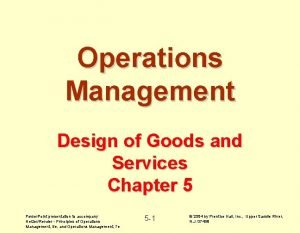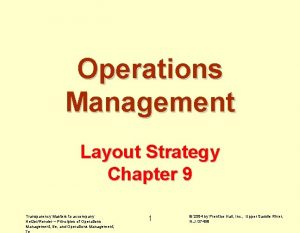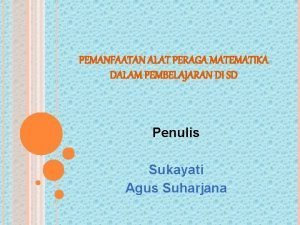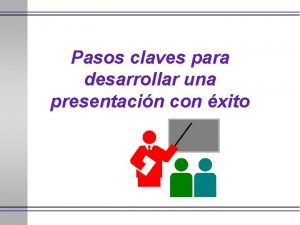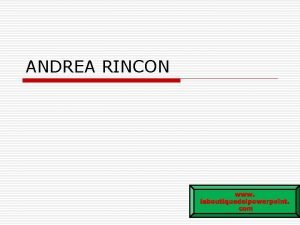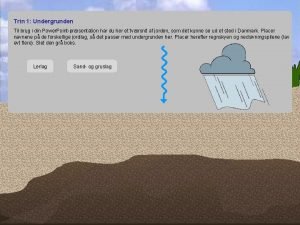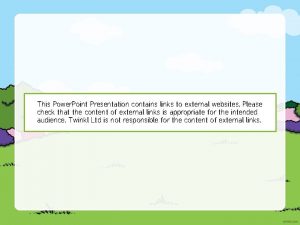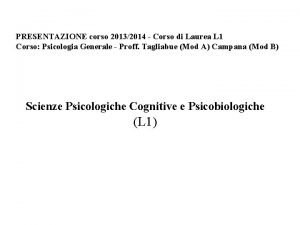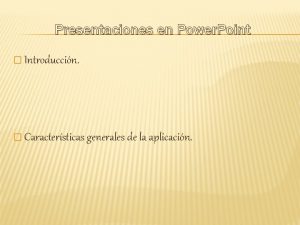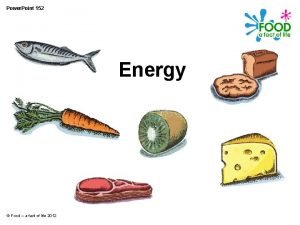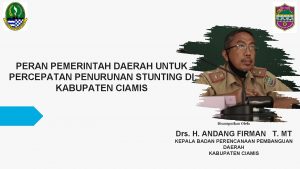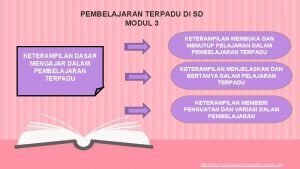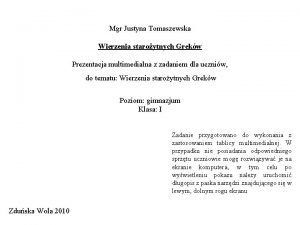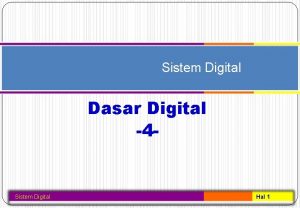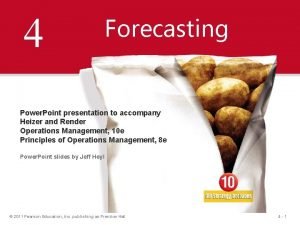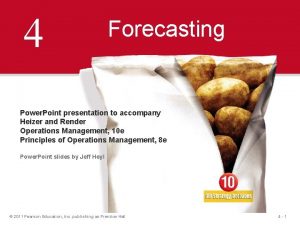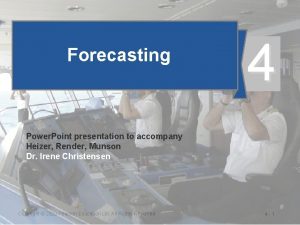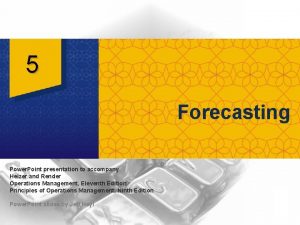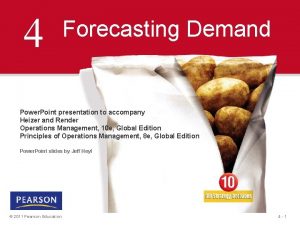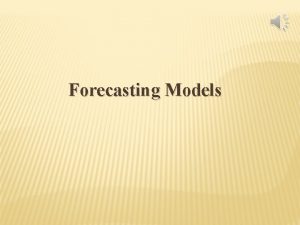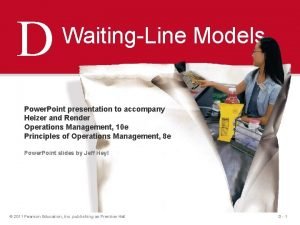Forecasting 4 Power Point presentation to accompany Heizer












































































































- Slides: 108

Forecasting 4 Power. Point presentation to accompany Heizer and Render Operations Management, Eleventh Edition Principles of Operations Management, Ninth Edition Power. Point slides by Jeff Heyl © 2014 Pearson Education, Inc. 4 -1

Outline ▶ What Is Forecasting? ▶ The Strategic Importance of Forecasting ▶ Seven Steps in the Forecasting System ▶ Forecasting Approaches © 2014 Pearson Education, Inc. 4 -2

Outline - Continued ▶ Time-Series Forecasting ▶ Associative Forecasting Methods: Regression and Correlation Analysis ▶ Monitoring and Controlling Forecasts ▶ Forecasting in the Service Sector © 2014 Pearson Education, Inc. 4 -3

Learning Objectives When you complete this chapter you should be able to : 1. Understand the three time horizons and which models apply for each use 2. Explain when to use each of the four qualitative models 3. Apply the naive, moving average, exponential smoothing, and trend methods © 2014 Pearson Education, Inc. 4 -4

Learning Objectives When you complete this chapter you should be able to : 4. Compute three measures of forecast accuracy 5. Develop seasonal indices 6. Conduct a regression and correlation analysis 7. Use a tracking signal © 2014 Pearson Education, Inc. 4 -5

What is Forecasting? ► ► Process of predicting a future event Underlying basis of all business decisions ► Production ► Inventory ► Personnel ► Facilities © 2014 Pearson Education, Inc. ? ? 4 -6

Forecasting Time Horizons 1. Short-range forecast ► ► Up to 1 year, generally less than 3 months Purchasing, job scheduling, workforce levels, job assignments, production levels 2. Medium-range forecast ► 3 months to 3 years ► Sales and production planning, budgeting 3. Long-range forecast ► ► 3+ years New product planning, facility location, research and development © 2014 Pearson Education, Inc. 4 -7

Distinguishing Differences 1. Medium/long range forecasts deal with more comprehensive issues and support management decisions regarding planning and products, plants and processes 2. Short-term forecasting usually employs different methodologies than longer-term forecasting 3. Short-term forecasts tend to be more accurate than longer-term forecasts © 2014 Pearson Education, Inc. 4 -8

Influence of Product Life Cycle Introduction – Growth – Maturity – Decline ► ► Introduction and growth require longer forecasts than maturity and decline As product passes through life cycle, forecasts are useful in projecting ► Staffing levels ► Inventory levels ► Factory capacity © 2014 Pearson Education, Inc. 4 -9

Types of Forecasts 1. Economic forecasts ► Address business cycle – inflation rate, money supply, housing starts, etc. 2. Technological forecasts ► Predict rate of technological progress ► Impacts development of new products 3. Demand forecasts ► Predict sales of existing products and services © 2014 Pearson Education, Inc. 4 - 10

Seven Steps in Forecasting 1. Determine the use of the forecast 2. Select the items to be forecasted 3. Determine the time horizon of the forecast 4. Select the forecasting model(s) 5. Gather the data needed to make the forecast 6. Make the forecast 7. Validate and implement results © 2014 Pearson Education, Inc. 4 - 11

The Realities! ► ► ► Forecasts are seldom perfect, unpredictable outside factors may impact the forecast Most techniques assume an underlying stability in the system Product family and aggregated forecasts are more accurate than individual product forecasts © 2014 Pearson Education, Inc. 4 - 12

Forecasting Approaches Qualitative Methods ► ► Used when situation is vague and little data exist ► New products ► New technology Involves intuition, experience ► e. g. , forecasting sales on Internet © 2014 Pearson Education, Inc. 4 - 13

Forecasting Approaches Quantitative Methods ► ► Used when situation is ‘stable’ and historical data exist ► Existing products ► Current technology Involves mathematical techniques ► e. g. , forecasting sales of color televisions © 2014 Pearson Education, Inc. 4 - 14

Overview of Qualitative Methods 1. Jury of executive opinion ► Pool opinions of high-level experts, sometimes augment by statistical models 2. Delphi method ► Panel of experts, queried iteratively © 2014 Pearson Education, Inc. 4 - 15

Overview of Qualitative Methods 3. Sales force composite ► Estimates from individual salespersons are reviewed for reasonableness, then aggregated 4. Market Survey ► Ask the customer © 2014 Pearson Education, Inc. 4 - 16

Jury of Executive Opinion ► ► ► Involves small group of high-level experts and managers Group estimates demand by working together Combines managerial experience with statistical models Relatively quick ‘Group-think’ disadvantage © 2014 Pearson Education, Inc. 4 - 17

Delphi Method Iterative group process, continues until consensus is reached Staff ► 3 types of (Administering survey) participants ► ► Decision makers ► Staff ► Respondents © 2014 Pearson Education, Inc. Decision Makers (Evaluate responses and make decisions) Respondents (People who can make valuable judgments) 4 - 18

Sales Force Composite ► ► Each salesperson projects his or her sales Combined at district and national levels ► Sales reps know customers’ wants ► May be overly optimistic © 2014 Pearson Education, Inc. 4 - 19

Market Survey ► ► Ask customers about purchasing plans Useful for demand product design and planning What consumers say, and what they actually do may be different May be overly optimistic © 2014 Pearson Education, Inc. 4 - 20

Overview of Quantitative Approaches 1. Naive approach 2. Moving averages 3. Exponential smoothing 4. Trend projection 5. Linear regression © 2014 Pearson Education, Inc. Time-series models Associative model 4 - 21

Time-Series Forecasting ► Set of evenly spaced numerical data ► ► Obtained by observing response variable at regular time periods Forecast based only on past values, no other variables important ► Assumes that factors influencing past and present will continue influence in future © 2014 Pearson Education, Inc. 4 - 22

Time-Series Components Trend Cyclical Seasonal Random © 2014 Pearson Education, Inc. 4 - 23

Components of Demand for product or service Trend component Seasonal peaks Actual demand line Average demand over 4 years Random variation | 1 © 2014 Pearson Education, Inc. | 2 | | 3 4 Time (years) Figure 4. 1 4 - 24

Trend Component Persistent, overall upward or downward pattern ► Changes due to population, technology, age, culture, etc. ► Typically several years duration ► © 2014 Pearson Education, Inc. 4 - 25

Seasonal Component ► ► ► Regular pattern of up and down fluctuations Due to weather, customs, etc. Occurs within a single year PERIOD LENGTH “SEASON” LENGTH NUMBER OF “SEASONS” IN PATTERN Week Day Month Week 4 – 4. 5 Month Day 28 – 31 Year Quarter 4 Year Month 12 Year Week 52 © 2014 Pearson Education, Inc. 7 4 - 26

Cyclical Component ► ► Repeating up and down movements Affected by business cycle, political, and economic factors Multiple years duration Often causal or associative relationships 0 © 2014 Pearson Education, Inc. 5 10 15 20 4 - 27

Random Component ► ► ► Erratic, unsystematic, ‘residual’ fluctuations Due to random variation or unforeseen events Short duration and nonrepeating © 2014 Pearson Education, Inc. M F T W T 4 - 28

Naive Approach ► Assumes demand in next period is the same as demand in most recent period ► ► ► e. g. , If January sales were 68, then February sales will be 68 Sometimes cost effective and efficient Can be good starting point © 2014 Pearson Education, Inc. 4 - 29

Moving Average Method ► ► ► MA is a series of arithmetic means Used if little or no trend Used often for smoothing ► Provides overall impression of data over time © 2014 Pearson Education, Inc. 4 - 30

Moving Average Example MONTH ACTUAL SHED SALES January 10 February 12 March 13 April 16 (10 + 12 + 13)/3 = 11 2/3 May 19 (12 + 13 + 16)/3 = 13 2/3 June 23 (13 + 16 + 19)/3 = 16 July 26 (16 + 19 + 23)/3 = 19 1/3 August 30 (19 + 23 + 26)/3 = 22 2/3 September 28 (23 + 26 + 30)/3 = 26 1/3 October 18 (29 + 30 + 28)/3 = 28 November 16 (30 + 28 + 18)/3 = 25 1/3 December 14 (28 + 16)/3 = 20 2/3 © 2014 Pearson Education, Inc. 3 -MONTH MOVING AVERAGE 4 - 31

Weighted Moving Average ► Used when some trend might be present ► ► Older data usually less important Weights based on experience and intuition Weighted moving average © 2014 Pearson Education, Inc. 4 - 32

Weighted Moving Average MONTH ACTUAL SHED SALES January 10 February 12 March 13 April 16 May [(3 x 13) + (2 x 12) + (10)]/6 = 12 1/6 19 WEIGHTS APPLIED 23 June 3 -MONTH WEIGHTED MOVING AVERAGE PERIOD July 26 3 Last month August 30 2 Two months ago September 28 1 Three months ago October November 18 6 Forecast for 16 this month = December Sum of the weights 3 x 14 Sales last mo. + 2 x Sales 2 mos. ago + 1 x Sales 3 mos. ago Sum of the weights © 2014 Pearson Education, Inc. 4 - 33

Weighted Moving Average MONTH ACTUAL SHED SALES January 10 February 12 March 13 April 16 [(3 x 13) + (2 x 12) + (10)]/6 = 12 1/6 May 19 [(3 x 16) + (2 x 13) + (12)]/6 = 14 1/3 June 23 [(3 x 19) + (2 x 16) + (13)]/6 = 17 July 26 [(3 x 23) + (2 x 19) + (16)]/6 = 20 1/2 August 30 [(3 x 26) + (2 x 23) + (19)]/6 = 23 5/6 September 28 [(3 x 30) + (2 x 26) + (23)]/6 = 27 1/2 October 18 [(3 x 28) + (2 x 30) + (26)]/6 = 28 1/3 November 16 [(3 x 18) + (2 x 28) + (30)]/6 = 23 1/3 December 14 [(3 x 16) + (2 x 18) + (28)]/6 = 18 2/3 © 2014 Pearson Education, Inc. 3 -MONTH WEIGHTED MOVING AVERAGE 4 - 34

Potential Problems With Moving Average Increasing n smooths the forecast but makes it less sensitive to changes ► Does not forecast trends well ► Requires extensive historical data ► © 2014 Pearson Education, Inc. 4 - 35

Graph of Moving Averages Weighted moving average 30 – Sales demand 25 – 20 – 15 – Actual sales Moving average 10 – 5– | | | J F M A M J J Month Figure 4. 2 © 2014 Pearson Education, Inc. | | | A S O N D 4 - 36

Exponential Smoothing ► ► ► Form of weighted moving average ► Weights decline exponentially ► Most recent data weighted most Requires smoothing constant ( ) ► Ranges from 0 to 1 ► Subjectively chosen Involves little record keeping of past data © 2014 Pearson Education, Inc. 4 - 37

Exponential Smoothing New forecast = Last period’s forecast + (Last period’s actual demand – Last period’s forecast) Ft = Ft – 1 + (At – 1 - Ft – 1) where Ft = new forecast Ft – 1 = = previous period’s forecast smoothing (or weighting) constant (0 ≤ ≤ 1) At – 1 = previous period’s actual demand © 2014 Pearson Education, Inc. 4 - 38

Exponential Smoothing Example Predicted demand = 142 Ford Mustangs Actual demand = 153 Smoothing constant =. 20 © 2014 Pearson Education, Inc. 4 - 39

Exponential Smoothing Example Predicted demand = 142 Ford Mustangs Actual demand = 153 Smoothing constant =. 20 New forecast = 142 +. 2(153 – 142) © 2014 Pearson Education, Inc. 4 - 40

Exponential Smoothing Example Predicted demand = 142 Ford Mustangs Actual demand = 153 Smoothing constant =. 20 New forecast = 142 +. 2(153 – 142) = 142 + 2. 2 = 144. 2 ≈ 144 cars © 2014 Pearson Education, Inc. 4 - 41

Effect of Smoothing Constants ▶ Smoothing constant generally. 05 ≤ ≤. 50 ▶ As increases, older values become less significant WEIGHT ASSIGNED TO SMOOTHING CONSTANT MOST RECENT PERIOD ( ) 2 ND MOST RECENT PERIOD (1 – ) 3 RD MOST RECENT PERIOD (1 – )2 4 th MOST RECENT PERIOD (1 – )3 5 th MOST RECENT PERIOD (1 – )4 =. 1 . 09 . 081 . 073 . 066 =. 5 . 25 . 125 . 063 . 031 © 2014 Pearson Education, Inc. 4 - 42

Impact of Different Demand 225 – Actual demand 200 – =. 5 175 – =. 1 150 – | 1 | 2 | 3 | 4 | 5 | 6 | 7 | 8 | 9 Quarter © 2014 Pearson Education, Inc. 4 - 43

Impact of Different 225 – Demand ► Actual demand values =. 5 Choose high of when underlying average is likely to change 200 – Choose low values of when underlying average is stable | | | | ► 175 – 150 – 1 2 3 4 5 6 7 8 =. 1 | 9 Quarter © 2014 Pearson Education, Inc. 4 - 44

Choosing The objective is to obtain the most accurate forecast no matter the technique We generally do this by selecting the model that gives us the lowest forecast error Forecast error = Actual demand – Forecast value = At – Ft © 2014 Pearson Education, Inc. 4 - 45

Common Measures of Error Mean Absolute Deviation (MAD) © 2014 Pearson Education, Inc. 4 - 46

Determining the MAD QUARTER ACTUAL TONNAGE UNLOADED 1 180 175 2 168 175. 50 = 175. 00 +. 10(180 – 175) 177. 50 3 159 174. 75 = 175. 50 +. 10(168 – 175. 50) 172. 75 4 175 173. 18 = 174. 75 +. 10(159 – 174. 75) 165. 88 5 190 173. 36 = 173. 18 +. 10(175 – 173. 18) 170. 44 6 205 175. 02 = 173. 36 +. 10(190 – 173. 36) 180. 22 7 180 178. 02 = 175. 02 +. 10(205 – 175. 02) 192. 61 8 182 178. 22 = 178. 02 +. 10(180 – 178. 02) 186. 30 9 ? 178. 59 = 178. 22 +. 10(182 – 178. 22) 184. 15 © 2014 Pearson Education, Inc. FORECAST WITH =. 10 FORECAST WITH =. 50 4 - 47

Determining the MAD QUARTER ACTUAL TONNAGE UNLOADED FORECAST WITH =. 10 1 180 175 5. 00 2 168 175. 50 7. 50 177. 50 9. 50 3 159 174. 75 15. 75 172. 75 13. 75 4 175 173. 18 1. 82 165. 88 9. 12 5 190 173. 36 16. 64 170. 44 19. 56 6 205 175. 02 29. 98 180. 22 24. 78 7 180 178. 02 1. 98 192. 61 12. 61 8 182 178. 22 3. 78 186. 30 4. 30 Sum of absolute deviations: MAD = © 2014 Pearson Education, Inc. Σ|Deviations| n ABSOLUTE DEVIATION FOR a =. 10 FORECAST WITH =. 50 ABSOLUTE DEVIATION FOR a =. 50 82. 45 98. 62 10. 31 12. 33 4 - 48

Common Measures of Error Mean Squared Error (MSE) © 2014 Pearson Education, Inc. 4 - 49

Determining the MSE QUARTER ACTUAL TONNAGE UNLOADED 1 180 175 2 168 175. 50 (– 7. 5)2 = 56. 25 3 159 174. 75 (– 15. 75)2 = 248. 06 4 175 173. 18 (1. 82)2 = 3. 31 5 190 173. 36 (16. 64)2 = 276. 89 6 205 175. 02 (29. 98)2 = 898. 80 7 180 178. 02 (1. 98)2 = 3. 92 8 182 178. 22 (3. 78)2 = 14. 29 FORECAST FOR =. 10 (ERROR)2 52 = 25 Sum of errors squared = 1, 526. 52 © 2014 Pearson Education, Inc. 4 - 50

Common Measures of Error Mean Absolute Percent Error (MAPE) © 2014 Pearson Education, Inc. 4 - 51

Determining the MAPE QUARTER ACTUAL TONNAGE UNLOADED FORECAST FOR =. 10 1 180 175. 00 100(5/180) = 2. 78% 2 168 175. 50 100(7. 5/168) = 4. 46% 3 159 174. 75 100(15. 75/159) = 9. 90% 4 175 173. 18 100(1. 82/175) = 1. 05% 5 190 173. 36 100(16. 64/190) = 8. 76% 6 205 175. 02 100(29. 98/205) = 14. 62% 7 180 178. 02 100(1. 98/180) = 1. 10% 8 182 178. 22 100(3. 78/182) = 2. 08% ABSOLUTE PERCENT ERROR 100(ERROR/ACTUAL) Sum of % errors = 44. 75% © 2014 Pearson Education, Inc. 4 - 52

Comparison of Forecast Error Rounded Absolute Actual Forecast Deviation Tonnagewith for Quarter Unloaded =. 10 =. 50 1 2 3 4 5 6 7 8 180 175 5. 00 168 175. 5 7. 50 177. 50 159 174. 75 15. 75 172. 75 173. 18 1. 82 165. 88 190 173. 36 16. 64 170. 44 205 175. 02 29. 98 180. 22 180 178. 02 1. 98 192. 61 182 178. 22 3. 78 186. 30 82. 45 98. 62 © 2014 Pearson Education, Inc. 9. 50 13. 75 9. 12 19. 56 24. 78 12. 61 4. 30 4 - 53

Comparison of Forecast Error Rounded Absolute ∑ |deviations| Actual Forecast Deviation MAD = Tonnagewith for Quarter Unloaded a =n. 10 a =. 10 =. 50 1 For 180 175 =5. 00. 10 175 5. 00 2 168 175. 5 7. 50 177. 50 9. 50 82. 45/8 = 10. 31 3 159 174. 75 =15. 75 172. 75 13. 75 4 175 173. 18 1. 82 165. 88 9. 12 =. 5016. 64 170. 44 19. 56 5 For 190 173. 36 6 205 175. 02=29. 98 180. 22 24. 78 98. 62/8 = 12. 33 7 180 178. 02 1. 98 192. 61 12. 61 8 182 178. 22 3. 78 186. 30 4. 30 82. 45 98. 62 © 2014 Pearson Education, Inc. 4 - 54

Comparison of Forecast Error Rounded Absolute Rounded 2 Absolute ∑ (forecast errors) Forecast Deviation MSEActual = Tonnagewith for withnfor Quarter Unloaded a =. 10 =. 50 1 For 180 175 =5. 00. 10 175 5. 00 2 168 175. 5 7. 50 177. 50 9. 50 = 1, 526. 54/8 = 190. 82 3 159 174. 75 15. 75 172. 75 13. 75 4 175 173. 18 1. 82 165. 88 9. 12 =. 5016. 64 170. 44 19. 56 5 For 190 173. 36 6 205 175. 02 29. 98 180. 22 24. 78 = 1, 561. 91/8 = 195. 24 7 180 178. 02 1. 98 192. 61 12. 61 8 182 178. 22 3. 78 186. 30 4. 30 82. 45 98. 62 MAD 10. 31 12. 33 © 2014 Pearson Education, Inc. 4 - 55

Comparison of Forecast Error n ∑ Rounded 100|deviation Absolute Rounded Absolute i|/actual i Actual Forecast Deviation MAPE = i=1 Tonnagewith for n=. 10 a =. 50 Quarter Unloaded a =. 10 a 1 2 3 4 5 6 7 8 180 175 For 5. 00 =. 10 175 5. 00 168 175. 5 7. 50 177. 50 9. 50 = 44. 75/8 5. 59% 159 174. 75 15. 75 172. 75 =13. 75 173. 18 1. 82 165. 88 9. 12 For =. 50 190 173. 36 16. 64 170. 44 19. 56 205 175. 02 29. 98 180. 22=24. 78 = 54. 05/8 6. 76% 180 178. 02 1. 98 192. 61 182 178. 22 3. 78 186. 30 4. 30 82. 45 98. 62 MAD 10. 31 12. 33 MSE 190. 82 195. 24 © 2014 Pearson Education, Inc. 4 - 56

Comparison of Forecast Error Rounded Absolute Actual Forecast Deviation Tonnagewith for Quarter Unloaded =. 10 =. 50 1 2 3 4 5 6 7 8 180 175 5. 00 168 175. 5 7. 50 177. 50 9. 50 159 174. 75 15. 75 172. 75 13. 75 173. 18 1. 82 165. 88 9. 12 190 173. 36 16. 64 170. 44 19. 56 205 175. 02 29. 98 180. 22 24. 78 180 178. 02 1. 98 192. 61 182 178. 22 3. 78 186. 30 4. 30 82. 45 98. 62 MAD 10. 31 12. 33 MSE 190. 82 195. 24 MAPE 5. 59% 6. 76% © 2014 Pearson Education, Inc. 4 - 57

Trend Projections Fitting a trend line to historical data points to project into the medium to long-range Linear trends can be found using the least squares technique y^ = a + bx where y^ = computed value of the variable to be predicted (dependent variable) a = y-axis intercept b = slope of the regression line x = the independent variable © 2014 Pearson Education, Inc. 4 - 58

Values of Dependent Variable (y-values) Least Squares Method Actual observation (y-value) Deviation 7 Deviation 5 Deviation 3 Deviation 1 (error) Deviation 6 Least squares method minimizes the sum of Deviation the squared errors (deviations) 4 Deviation 2 Trend line, y^ = a + bx | | | | 1 2 3 4 5 6 7 Time period © 2014 Pearson Education, Inc. Figure 4. 4 4 - 59

Least Squares Method Equations to calculate the regression variables © 2014 Pearson Education, Inc. 4 - 60

Least Squares Example YEAR ELECTRICAL POWER DEMAND 1 74 5 105 2 79 6 142 3 80 7 122 4 90 © 2014 Pearson Education, Inc. 4 - 61

Least Squares Example YEAR (x) ELECTRICAL POWER DEMAND (y) x 2 xy 1 74 2 79 4 158 3 80 9 240 4 90 16 360 5 105 25 525 6 142 36 852 7 122 49 854 Σx = 28 © 2014 Pearson Education, Inc. Σy = 692 Σx 2 = 140 Σxy = 3, 063 4 - 62

Least Squares Example YEAR (x) ELECTRICAL POWER DEMAND (y) x 2 xy 1 74 2 79 4 158 3 80 9 240 4 90 16 360 5 105 25 525 6 142 36 852 7 122 49 854 Σx = 28 Σy = 692 Σx 2 = 140 Σxy = 3, 063 Demand in year 8 = 56. 70 + 10. 54(8) = 141. 02, or 141 megawatts © 2014 Pearson Education, Inc. 4 - 63

Power demand (megawatts) Least Squares Example 160 150 140 130 120 110 100 90 80 70 60 50 – – – Trend line, y^ = 56. 70 + 10. 54 x | 1 | 2 © 2014 Pearson Education, Inc. | 3 | 4 | 5 | 6 | | 7 8 Year | 9 Figure 4. 5 4 - 64

Least Squares Requirements 1. We always plot the data to insure a linear relationship 2. We do not predict time periods far beyond the database 3. Deviations around the least squares line are assumed to be random © 2014 Pearson Education, Inc. 4 - 65

Seasonal Variations In Data The multiplicative seasonal model can adjust trend data for seasonal variations in demand © 2014 Pearson Education, Inc. 4 - 66

Seasonal Variations In Data Steps in the process for monthly seasons: 1. Find average historical demand for each month 2. Compute the average demand over all months 3. Compute a seasonal index for each month 4. Estimate next year’s total demand 5. Divide this estimate of total demand by the number of months, then multiply it by the seasonal index for that month © 2014 Pearson Education, Inc. 4 - 67

Seasonal Index Example DEMAND MONTH YEAR 1 YEAR 2 YEAR 3 AVERAGE YEARLY DEMAND Jan 80 85 105 90 Feb 70 85 85 80 Mar 80 93 82 85 Apr 90 95 115 100 May 113 125 131 123 June 110 115 120 115 July 100 102 113 105 Aug 88 102 110 100 Sept 85 90 95 90 Oct 77 78 85 80 Nov 75 82 83 80 Dec 82 78 80 80 Total average annual demand = © 2014 Pearson Education, Inc. AVERAGE MONTHLY DEMAND SEASONAL INDEX 1, 128 4 - 68

Seasonal Index Example DEMAND MONTH YEAR 1 YEAR 2 YEAR 3 AVERAGE YEARLY DEMAND AVERAGE MONTHLY DEMAND Jan 80 85 105 90 94 Feb 70 85 85 80 94 80 93 82 85 94 95 115 100 94 125 131 123 94 115 120 115 94 Mar June Average 90 monthly 113 demand 110 July 100 102 113 105 94 Aug 88 102 110 100 94 Sept 85 90 94 Oct 77 78 85 80 94 Nov 75 82 83 80 94 Dec 82 78 80 80 94 Apr May Total average annual demand = © 2014 Pearson Education, Inc. SEASONAL INDEX 1, 128 4 - 69

Seasonal Index Example DEMAND MONTH YEAR 1 YEAR 2 YEAR 3 AVERAGE YEARLY DEMAND AVERAGE MONTHLY DEMAND Jan 80 85 105 90 94 Feb 70 85 85 80 94 Mar 80 93 82 85 94 Apr 90 95 115 100 94 May 113 125 131 123 94 Seasonal 110 June 115 120 115 94 index 100 102 113 105 94 Aug 88 102 110 100 94 Sept 85 90 94 Oct 77 78 85 80 94 Nov 75 82 83 80 94 Dec 82 78 80 80 94 July Total average annual demand = © 2014 Pearson Education, Inc. SEASONAL INDEX. 957( = 90/94) 1, 128 4 - 70

Seasonal Index Example DEMAND MONTH YEAR 1 YEAR 2 YEAR 3 AVERAGE YEARLY DEMAND AVERAGE MONTHLY DEMAND SEASONAL INDEX Jan 80 85 105 90 94 . 957( = 90/94) Feb 70 85 85 80 94 . 851( = 80/94) Mar 80 93 82 85 94 . 904( = 85/94) Apr 90 95 115 100 94 1. 064( = 100/94) May 113 125 131 123 94 1. 309( = 123/94) June 110 115 120 115 94 1. 223( = 115/94) July 100 102 113 105 94 1. 117( = 105/94) Aug 88 102 110 100 94 1. 064( = 100/94) Sept 85 90 94 . 957( = 90/94) Oct 77 78 85 80 94 . 851( = 80/94) Nov 75 82 83 80 94 . 851( = 80/94) Dec 82 78 80 80 94 . 851( = 80/94) Total average annual demand = © 2014 Pearson Education, Inc. 1, 128 4 - 71

Seasonal Index Example Seasonal forecast for Year 4 MONTH Jan DEMAND 1, 200 12 Feb 1, 200 12 Mar 1, 200 12 Apr 1, 200 12 May 1, 200 12 June 1, 200 12 © 2014 Pearson Education, Inc. x. 957 = 96 x. 851 = 85 x. 904 = 90 x 1. 064 = 106 x 1. 309 = 131 x 1. 223 = 122 MONTH July DEMAND 1, 200 12 Aug 1, 200 12 Sept 1, 200 12 Oct 1, 200 12 Nov 1, 200 12 Dec 1, 200 12 x 1. 117 = 112 x 1. 064 = 106 x. 957 = 96 x. 851 = 85 4 - 72

Seasonal Index Example Year 4 Forecast Year 3 Demand Year 2 Demand Year 1 Demand 140 – 130 – Demand 120 – 110 – 100 – 90 – 80 – 70 – | J © 2014 Pearson Education, Inc. | F | M | A | M | | J J Time | A | S | O | N | D 4 - 73

San Diego Hospital Trend Data Figure 4. 6 10, 200 – Inpatient Days 10, 000 – 9, 800 – 9573 9, 600 – 9530 9, 400 – 9551 9659 9616 9594 9637 9745 9702 9680 9724 9766 9, 200 – 9, 000 – | | | Jan Feb Mar Apr May June July Aug Sept Oct Nov Dec 67 68 69 70 71 72 73 74 75 76 77 78 Month © 2014 Pearson Education, Inc. 4 - 74

San Diego Hospital Seasonality Indices for Adult Inpatient Days at San Diego Hospital MONTH SEASONALITY INDEX January 1. 04 July 1. 03 February 0. 97 August 1. 04 March 1. 02 September 0. 97 April 1. 01 October 1. 00 May 0. 99 November 0. 96 June 0. 99 December 0. 98 © 2014 Pearson Education, Inc. MONTH SEASONALITY INDEX 4 - 75

San Diego Hospital Figure 4. 7 Seasonal Indices Index for Inpatient Days 1. 06 – 1. 04 1. 02 – 1. 01 1. 00 0. 99 1. 00 – 0. 98 – 0. 96 – 1. 03 0. 98 0. 99 0. 97 0. 94 – 0. 92 – 1. 04 0. 96 | | | Jan Feb Mar Apr May June July Aug Sept Oct Nov Dec 67 68 69 70 71 72 73 74 75 76 77 78 Month © 2014 Pearson Education, Inc. 4 - 76

San Diego Hospital Period 67 68 69 70 71 72 Month Jan Feb Mar Apr May June 9, 911 9, 265 9, 164 9, 691 9, 520 9, 542 Period 73 74 75 76 77 78 Month July Aug Sept Oct Nov Dec 9, 949 10, 068 9, 411 9, 724 9, 355 9, 572 Forecast with Trend & Seasonality © 2014 Pearson Education, Inc. 4 - 77

San Diego Hospital Figure 4. 8 Combined Trend and Seasonal Forecast 10, 200 – 10068 9949 Inpatient Days 10, 000 – 9911 9764 9, 800 – 9724 9691 9572 9, 600 – 9520 9542 9, 400 – 9, 200 – 9, 000 – 9411 9265 9355 | | | Jan Feb Mar Apr May June July Aug Sept Oct Nov Dec 67 68 69 70 71 72 73 74 75 76 77 78 Month © 2014 Pearson Education, Inc. 4 - 78

Adjusting Trend Data Quarter I: Quarter III: Quarter IV: © 2014 Pearson Education, Inc. 4 - 79

Associative Forecasting Used when changes in one or more independent variables can be used to predict the changes in the dependent variable Most common technique is linear regression analysis We apply this technique just as we did in the time-series example © 2014 Pearson Education, Inc. 4 - 80

Associative Forecasting an outcome based on predictor variables using the least squares technique y^ = a + bx ^ © 2014 Pearson Education, Inc. where y = value of the dependent variable (in our example, sales) a = y-axis intercept b = slope of the regression line x = the independent variable 4 - 81

Associative Forecasting Example NODEL’S SALES (IN $ MILLIONS), y AREA PAYROLL (IN $ BILLIONS), x 2. 0 1 2. 0 2 3. 0 3 2. 0 1 2. 5 4 3. 5 7 Nodel’s sales (in$ millions) 4. 0 – 3. 0 – 2. 0 – 1. 0 – 0 | | | | 1 2 3 4 5 6 7 Area payroll (in $ billions) © 2014 Pearson Education, Inc. 4 - 82

Associative Forecasting Example SALES, y PAYROLL, x x 2 xy 2. 0 1 1 2. 0 3 9 9. 0 2. 5 4 16 10. 0 2 4 4. 0 2. 0 1 1 2. 0 3. 5 7 49 24. 5 Σy = 15. 0 © 2014 Pearson Education, Inc. Σx = 18 Σx 2 = 80 Σxy = 51. 5 4 - 83

Associative Forecasting Example SALES, y PAYROLL, x x 2 xy 2. 0 1 1 2. 0 3 9 9. 0 2. 5 4 16 10. 0 2 4 4. 0 2. 0 1 1 2. 0 3. 5 7 49 24. 5 Σy = 15. 0 © 2014 Pearson Education, Inc. Σx = 18 Σx 2 = 80 Σxy = 51. 5 4 - 84

Associative Forecasting Example SALES, y PAYROLL, x x 2 xy 1 1 2. 0 3 9 9. 0 2. 5 3. 0 – 2. 0 – 4 16 10. 0 2 4 4. 0 1 1 2. 0 3. 5 7 49 24. 5 2. 0 4. 0 – Nodel’s sales (in$ millions) 3. 0 Σy = 15. 0 1. 0 – Σx = | 0 © 2014 Pearson Education, Inc. Σx 2 = 18 1 | | | Σxy = 80 | | 51. 5 | 2 3 4 5 6 7 Area payroll (in $ billions) 4 - 85

Associative Forecasting Example If payroll next year is estimated to be $6 billion, then: Sales (in $ millions) = 1. 75 +. 25(6) = 1. 75 + 1. 5 = 3. 25 Sales = $3, 250, 000 © 2014 Pearson Education, Inc. 4 - 86

Associative Forecasting Example Nodel’s sales (in$ millions) If payroll 4. 0 next – year is estimated to be $6 billion, then: 3. 25 3. 0 – 2. 0 – Sales (in$ millions) = 1. 75 +. 25(6) 1. 0 – = 1. 75 + 1. 5 = 3. 25 | 0 Sales = © 2014 Pearson Education, Inc. | | | 1 2 3 4 5 6 7 $3, 250, 000 Area payroll (in $ billions) 4 - 87

Standard Error of the Estimate ► A forecast is just a point estimate of a future value This point is actually the mean of a probability distribution Nodel’s sales (in$ millions) ► 4. 0 – 3. 25 3. 0 – Regression line, 2. 0 – 1. 0 – | Figure 4. 9 © 2014 Pearson Education, Inc. | 0 7 | | 1 2 3 4 5 Area payroll (in $ billions) | 6 4 - 88

Standard Error of the Estimate where y = y-value of each data point yc = computed value of the dependent variable, from the regression equation n © 2014 Pearson Education, Inc. = number of data points 4 - 89

Standard Error of the Estimate Computationally, this equation is considerably easier to use We use the standard error to set up prediction intervals around the point estimate © 2014 Pearson Education, Inc. 4 - 90

The standard error of the estimate is $306, 000 in sales Nodel’s sales (in$ millions) Standard Error of the Estimate 4. 0 – 3. 25 3. 0 – 2. 0 – 1. 0 – | | 0 7 © 2014 Pearson Education, Inc. | | 1 2 3 4 5 Area payroll (in $ billions) | 6 4 - 91

Correlation ► ► ► How strong is the linear relationship between the variables? Correlation does not necessarily imply causality! Coefficient of correlation, r, measures degree of association ► Values range from -1 to +1 © 2014 Pearson Education, Inc. 4 - 92

Correlation Coefficient © 2014 Pearson Education, Inc. 4 - 93

Correlation Coefficient Figure 4. 10 y y x x (a) Perfect negative correlation y (e) Perfect positive correlation y y x x (b) Negative correlation (d) Positive correlation x (c) No correlation High Moderate | | | – 1. 0 – 0. 8 – 0. 6 © 2014 Pearson Education, Inc. | | Low | – 0. 4 – 0. 2 0. 4 Correlation coefficient values Moderate | | 0. 6 0. 8 High 1. 0 4 - 94

Correlation Coefficient y Σy = x x 2 xy y 2 2. 0 1 1 2. 0 4. 0 3 9 9. 0 2. 5 4 16 10. 0 6. 25 2. 0 2 4 4. 0 2. 0 1 1 2. 0 4. 0 3. 5 7 49 24. 5 12. 25 15. 0 Σx = © 2014 Pearson Education, Inc. 18 Σx 2 = 80 Σxy = 51. 5 Σy 2 = 39. 5 4 - 95

Correlation ► Coefficient of Determination, r 2, measures the percent of change in y predicted by the change in x ► Values range from 0 to 1 ► Easy to interpret For the Nodel Construction example: r =. 901 r 2 =. 81 © 2014 Pearson Education, Inc. 4 - 96

Multiple-Regression Analysis If more than one independent variable is to be used in the model, linear regression can be extended to multiple regression to accommodate several independent variables Computationally, this is quite complex and generally done on the computer © 2014 Pearson Education, Inc. 4 - 97

Multiple-Regression Analysis In the Nodel example, including interest rates in the model gives the new equation: An improved correlation coefficient of r =. 96 suggests this model does a better job of predicting the change in construction sales Sales = 1. 80 +. 30(6) - 5. 0(. 12) = 3. 00 Sales = $3, 000 © 2014 Pearson Education, Inc. 4 - 98

Monitoring and Controlling Forecasts Tracking Signal ► ► Measures how well the forecast is predicting actual values Ratio of cumulative forecast errors to mean absolute deviation (MAD) ► ► Good tracking signal has low values If forecasts are continually high or low, the forecast has a bias error © 2014 Pearson Education, Inc. 4 - 99

Monitoring and Controlling Forecasts Tracking = signal © 2014 Pearson Education, Inc. Cumulative error MAD 4 - 100

Tracking Signal Figure 4. 11 Signal exceeding limit Tracking signal + Upper control limit Acceptable range 0 MADs – Lower control limit Time © 2014 Pearson Education, Inc. 4 - 101

Tracking Signal Example ERROR CUM ERROR ABSOLUTE FORECAST ERROR CUM ABS FORECAST ERROR MAD TRACKING SIGNAL (CUM ERROR/MAD) 100 – 10 10. 0 – 10/10 = – 1 95 100 – 5 – 15 5 15 7. 5 – 15/7. 5 = – 2 3 115 100 +15 0 15 30 10. 0/10 = 0 4 100 110 – 10 10 40 10. 10/10 = – 1 5 125 110 +15 +5 15 55 11. 0 +5/11 = +0. 5 6 140 110 +35 30 85 14. 2 +35/14. 2 = +2. 5 QTR ACTUAL DEMAND FORECAST DEMAND 1 90 2 At the end of quarter 6, © 2014 Pearson Education, Inc. 4 - 102

Adaptive Smoothing ► ► It’s possible to use the computer to continually monitor forecast error and adjust the values of the and b coefficients used in exponential smoothing to continually minimize forecast error This technique is called adaptive smoothing © 2014 Pearson Education, Inc. 4 - 103

Focus Forecasting ► Developed at American Hardware Supply, based on two principles: 1. Sophisticated forecasting models are not always better than simple ones 2. There is no single technique that should be used for all products or services ► ► Uses historical data to test multiple forecasting models for individual items Forecasting model with the lowest error used to forecast the next demand © 2014 Pearson Education, Inc. 4 - 104

Forecasting in the Service Sector ► Presents unusual challenges ► ► Special need for short term records Needs differ greatly as function of industry and product ► Holidays and other calendar events ► Unusual events © 2014 Pearson Education, Inc. 4 - 105

Percentage of sales by hour of day Fast Food Restaurant Forecast 20% – Figure 4. 12 15% – 10% – 5% – 11 -12 1 -2 3 -4 5 -6 7 -8 9 -10 12 -1 2 -3 4 -5 6 -7 8 -9 10 -11 (Lunchtime) (Dinnertime) Hour of day © 2014 Pearson Education, Inc. 4 - 106

Fed. Ex Call Center Forecast Figure 4. 12 12% – 10% – 8% – 6% – 4% – 2% – 0% – 2 4 © 2014 Pearson Education, Inc. 6 8 A. M. 10 12 2 Hour of day 4 6 8 P. M. 10 12 4 - 107

All rights reserved. No part of this publication may be reproduced, stored in a retrieval system, or transmitted, in any form or by any means, electronic, mechanical, photocopying, recording, or otherwise, without the prior written permission of the publisher. Printed in the United States of America. © 2014 Pearson Education, Inc. 4 - 108
 Hebrews 6:9-12 sermon
Hebrews 6:9-12 sermon Michael heizer rift
Michael heizer rift Heizer city
Heizer city Accompany chapter 1
Accompany chapter 1 Goods and services design
Goods and services design Dorsal metacarpal veins
Dorsal metacarpal veins Layout strategies examples
Layout strategies examples Double negative heizer
Double negative heizer Inkjet printers are considered legacy technology
Inkjet printers are considered legacy technology Technology vs nature art
Technology vs nature art Subject and topic in hindi
Subject and topic in hindi Power point presentation design west vancouver
Power point presentation design west vancouver Triangle of power
Triangle of power Power bi power point
Power bi power point Point point power
Point point power Brow presentation birth
Brow presentation birth Vertex presentation and cephalic presentation
Vertex presentation and cephalic presentation Power tools safety training ppt
Power tools safety training ppt Point of view presentation
Point of view presentation The starting point in a presentation
The starting point in a presentation Solar power satellites and microwave power transmission
Solar power satellites and microwave power transmission Actual power and potential power
Actual power and potential power Flex28024a
Flex28024a What do you mean by dispersive power of grating
What do you mean by dispersive power of grating Power of a power property
Power of a power property Chain rule範例
Chain rule範例 Power angle curve in power system stability
Power angle curve in power system stability Power delivered vs power absorbed
Power delivered vs power absorbed Evangelio del domingo en power point
Evangelio del domingo en power point Como hacer un ova
Como hacer un ova Powerpoint boutique
Powerpoint boutique Power point tennis
Power point tennis Power point turing complete
Power point turing complete Powerpoint sul riciclo scuola media
Powerpoint sul riciclo scuola media Gambar blok dienes adalah
Gambar blok dienes adalah Pelajaran sekolah sabat dewasa
Pelajaran sekolah sabat dewasa Barni
Barni La boutique del power point
La boutique del power point La boutique del power point
La boutique del power point La boutique del powerpoint
La boutique del powerpoint Gizi kuliner
Gizi kuliner Decreto 1330 del 25 de julio de 2019
Decreto 1330 del 25 de julio de 2019 Conclusão apresentação power point
Conclusão apresentação power point Ejemplo de un portafolio
Ejemplo de un portafolio Cara mengoperasikan ppt
Cara mengoperasikan ppt Como poner potencias en power point
Como poner potencias en power point Disadvantages of power point
Disadvantages of power point Ventajas de power point
Ventajas de power point Presentazione power point tesina
Presentazione power point tesina La boutique del power point x
La boutique del power point x Contoh ppt rpp
Contoh ppt rpp Power point fisica
Power point fisica Power point
Power point Concentrese en power point
Concentrese en power point Bosquejos en power point
Bosquejos en power point Arte egizia ppt
Arte egizia ppt La boutique del powerpointx
La boutique del powerpointx La boutique del powerpoint pps
La boutique del powerpoint pps La boutique del powerpoint x
La boutique del powerpoint x La boutique del powerpoints
La boutique del powerpoints La boutique del powerpoint
La boutique del powerpoint La bestia del mar apocalipsis
La bestia del mar apocalipsis Plakat naukowy przykład
Plakat naukowy przykład Example of rhythm
Example of rhythm Temas de evangelismo
Temas de evangelismo Ventajas de powerpoint
Ventajas de powerpoint Power point
Power point La boutique del power point x
La boutique del power point x Powerpoint 2002
Powerpoint 2002 Komunikacja interpersonalna prezentacja power point
Komunikacja interpersonalna prezentacja power point Plantillas para power point
Plantillas para power point Grundvandspejling
Grundvandspejling Power point ethernet
Power point ethernet Power point links
Power point links Sistemas operativos mac
Sistemas operativos mac Presentazione power point tesi unipd psicologia
Presentazione power point tesi unipd psicologia Presentacin
Presentacin Narracion sonora en power point
Narracion sonora en power point Power point temple
Power point temple Power point links
Power point links Power point
Power point Power point tesis doctoral medicina
Power point tesis doctoral medicina Power point rembuk stunting
Power point rembuk stunting Resume modul 3 pembelajaran terpadu di sd
Resume modul 3 pembelajaran terpadu di sd Sunuyla ilgili kavramlar
Sunuyla ilgili kavramlar Organel sel hewan
Organel sel hewan Mitologia grecka prezentacja power point
Mitologia grecka prezentacja power point Materi listrik statis kelas 12 ppt
Materi listrik statis kelas 12 ppt Boutique ppt
Boutique ppt La boutique del power point
La boutique del power point Ppt materi jaringan hewan kelas xi
Ppt materi jaringan hewan kelas xi Presentación de inventarios en power point
Presentación de inventarios en power point Power point islamic
Power point islamic Mensaje a la 7 iglesias del apocalipsis
Mensaje a la 7 iglesias del apocalipsis Caso degollado power point
Caso degollado power point Power point
Power point Power point teks eksposisi kelas x
Power point teks eksposisi kelas x Prayer points for power and authority
Prayer points for power and authority Power point
Power point Ms power point
Ms power point Power point openoffice
Power point openoffice Przygotowywanie prezentacji
Przygotowywanie prezentacji Pengantar sistem digital
Pengantar sistem digital Materi menggambar ragam hias ppt
Materi menggambar ragam hias ppt Para power point
Para power point Text ade
Text ade Las barras de herramientas de power point
Las barras de herramientas de power point Jeopardy present perfect
Jeopardy present perfect Power point presantation
Power point presantation




